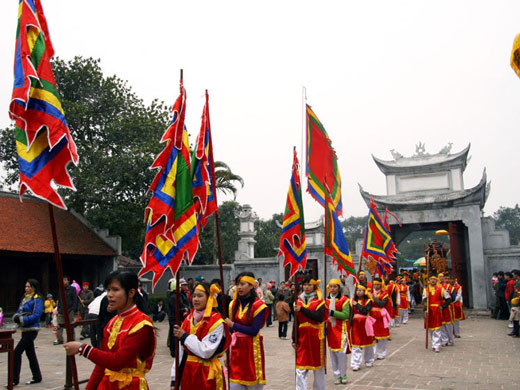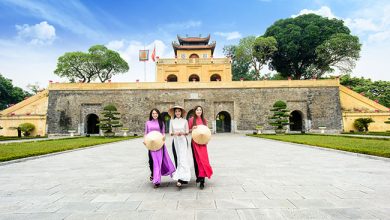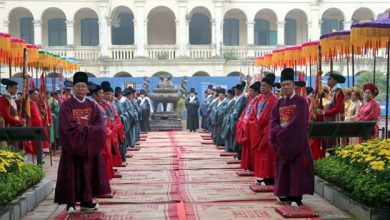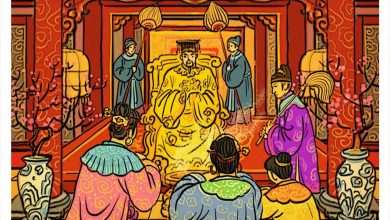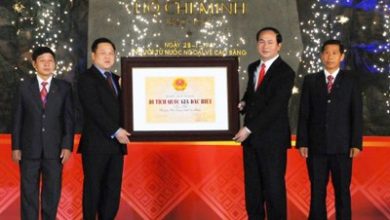Co Loa temple festival
Co Loa residents have a saying that “one may leave children after death but can not forget the 6th of first lunar month”. This festival used to be held annually on 6th of first lunar month until 1945 and then interrupted and it has been restored recently at large scale.
According to the Co Loa Geography Book, 6th of first lunar month is the date when the King Thuc Phan defeated Hung Kinh, returned from Hy Cuong and was enthroned. Annually, on this day the villagers made banh day. On the 9th of this month, the King conferred the title to the meritorious civil and military mandarins. And on 12th of this month, all people celebrated with feats and rejoicings
Co Loa festival is the one for “eight communes” in the old days that means all hamlets and villages of Co Loa commune today. The festival officially starts on 6th of the first lunar month. Co Loa villagers calls this festival “repeated New Year holiday”. “Eight communes” was because as in legend that when the King An Duong Vuong set up the capital in Co Loa, he established eight communes, each was responsible for its own task as assigned by the court.
Co Loa festival on the 6th of the first lunar month is the most significant festival in the year of Co Loa commune. Previously, the festival used to run for 12 days (6th – 18th), the year which suffered bad conditions (natural disasters, poor crop…), the festival was shortened to 6 days. Today, Co Loa festival is celebrated for 2 days (the 6th is the official festival).
Although the festival time is shortened, this is one of the most significant festivals in the area, not only residents of 15 hamlets and villages of Co Loa commune but so many people, visitors from surrounding communes are attracted by this festival. After the Grant sacrifices – offering ceremony celebrated in the morning of the 6th, statue of King An Duong Vuong is welcome to the communal house “Ngự triều di quy” and seated there for 12 days and be welcome back to Thuong temple. Legend has it that it was the time the King visited his daughter, My Chau.
During the festival, Quay Ca village is first in the queue without palanquin, other villages have their own Bat Cong palanquin. In addition, there are also palanquin of popcorn, palanquin of banh day. Quay Ca village is not in the list of eight communes, they are not required to take part in the sacrificed-offering ceremony to be conducted in Thuong temple in the morning of the 6th, however, as they are originated from Co Loa they are invited to participate in the festival and other communes have to welcome and receive them.
All preparations for the festival are made with care and completed on the afternoon of 5th. In the morning of 6th, eight communes take part in the grant sacrifices – offering ceremony in Thuong temple and then worshipping rituals begin in their communal house. Mach Trang festival lasts 12 days. It is believed by the local people in the old days that the 6th of the first lunar month is the day when the King An Duong Vuong ascended the throne, coronation was conducted on the 9th and gave a feast to the troops and all activities finished on the 12th.
In the procession to Co Loa in the morning of the 6th, escorts holding flags and weapons were controlled by 2 Thu Hieu men (one holding gong, one beating the control drum) who were selected annually by the villagers on 23rd of lunar December of previous year. Today, all of this is undertaken by 5 people of the Reception board.
After the grant sacrifices – offerings ceremony, Co Loa village leads the procession from Thuong Temple to around Ngoc well and to Ngu Trieu Di Quy communal house and then only Co Loa village delegation go into the communal house while others come back to their communal houses to carry out their own ceremonies.
In the procession from other villages to Co Loa, there are 16 people carrying out palanquins, gong and drum troop, 10 people carrying 10 big flags leading, 4 people carrying 4 smaller flags, 10 people in the offering team wearing long shirts, 1 Thu Hieu, 2 – 3 Bai Sat responsible for arranging the sequence of procession. Palanquin carriers wear brown loose-fitting blouse (armors) with embroidery, white pants and turbans. Flag carriers wear long shirts, red cloth tied on the left rib. Thu Hieu wears a tunic and black turban. Villagers are the last to follow.
An offering team of Co Loa village includes 24 people. Officiating man, who is annually selected by the villagers, is one of the notables (has a happy family), has good health, 60-65 years of age. The 14th of lunar December is “Nhap Tich” ceremony, it is also the day when the former Officiating man handing over the duty for the new one. This ceremony is usually held in families. In old days, this ceremony was compulsory but now it is optional. Before taking office, the new Officiating man must not “sleep” with his wife for a year, spending one year attending seance ritual, in charge of the affairs in the communal house, temple. 2 – 3 people are selected by each hamlet to take part in the offering team.
Order of the procession:
- 14 people carrying 14 flags
- 1 wood horse
- Swords, eight weapons
- 2 pennants carried by 2 heads of hamlets.
- 1 red container, in which are votive offerings: sticky rice and boiled chicken, truncated cone-shaped cakes made of sticky rice …
- 2 palanquins: palanquin of An Duong Vuong leading and palanquin of My Chau following.
The offering team includes 12 people who are selected from 4 hamlets (3 people of each hamlet: Lình, Nhì, Đăng cai). The procession to Co Loa is leaded by a person who is in charge of offering incense and votive offerings.
The participants in offering rituals wear deep blue tunic, white pants, hats, mandarin’s boots.
There must be 30 – 40 people in the delegation for the general offering ceremony to be held in Thuong temple on the 6th of the first lunar month. They are selected from 8 communes, names of whom have been listed in the last lunar month of the previous year including Officiating man being Co Loa villager and the oration reader must be Van Thuong villager. The Officiating man dresses in yellow while oration reader in red. In old days, only elderly men took part in the offering delegation but now there are also elderly women.
Representatives of the communes carry 8 palanquins into the yard.
In the offering ceremony, the Officiating man sits in the middle and others go in 2 sidelines. Oration carrier and oration reader are selected by the offering team and the Officiating man is selected by the offering committee.
After offerings ceremony in Thuong temple, Co Loa arranges 5 blocks of popcorn in the Palanquin for each procession delegation. The procession delegations then go around the semicircle lake in front of Thuong temple for one time in order (Mach Trang is the third). The 3 villages of Mach Trang, Van Thuong and Ngoai Sat come to Ba Cha temple to burn incenses and later dismiss while others come back to their communal houses.
After the offerings ceremony in Thuong temple, Mach Trang villagers come back to celebrate in their own communal house until the 12th of January. The ceremony in Mach Trang communal house includes an Officiating man, an oration reader, 2 light holders, 2 people beating gongs and drums, one carrying the west parasol and one holding the east parasol…30 people altogether. Offerings include banh day, cake with sesame, popcorn and truncated cone-shaped sticky rice.
There are feasts in the festival including one with food on the 6th, 9th and 12th of lunar January and another with sweets and fruits on the 7th, 10th, and 11th of lunar January. The latter is in turn organized by the 4 hamlets while in the former, each hamlet has to contribute a pig for food.
During 12-day festival, offerings is conducted each day in the morning and in the afternoon so there are a total of 24 offerings sessions. Meals are not organized for the whole 8 communes. After festival, the families offer for obtaining a thurible from Thuong temple to be worshiped in their house.

